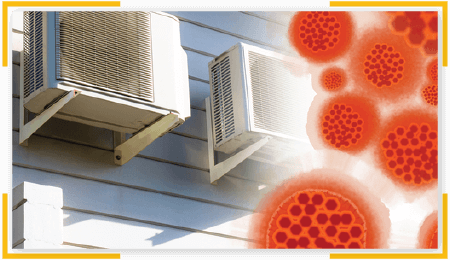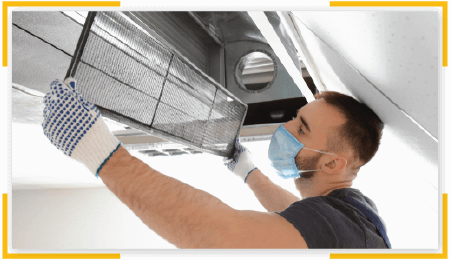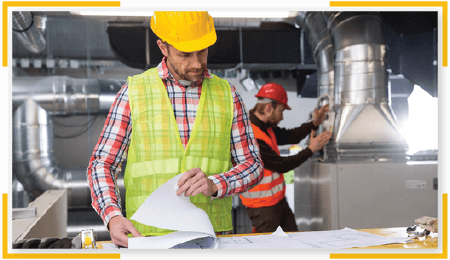Find out if your building is vulnerable to coronavirus, and identify the best prevention measures.
Configure your ventilation systems to help prevent the spread of coronavirus and other germs.
Identify the most effective air filtering and purification measures for your HVAC equipment.

According to the World Health Organization (WHO) and other health authorities, the 2019 coronavirus (SARS-CoV-2) is transmitted mostly within short distances. When infected persons sneeze or cough, they release large droplets that contain the virus, which normally fall within six feet. These viral particles can also be released when speaking loudly or yelling, Other persons can get infected with direct exposure to these droplets, or when they touch an infected surface and then touch their eyes, nose or mouth.
We are one of the fastest growing MEP design firms in the construction industry. We pride ourselves on having a fast turnaround while providing cost effective solutions. We are licensed in 50 states and are your one stop shop for all MEP design needs.
We are licensed in all 50 states!
We design to the perfection
Enjoy our lightening fast turnaround
We have completed so far!
Our designs are approved by DOB in one go
The best service experience in the market
According to the World Health Organization (WHO) and other health authorities, the 2019 coronavirus (SARS-CoV-2) is transmitted mostly within short distances. When infected persons sneeze or cough, they release large droplets that contain the virus, which normally fall within six feet. These viral particles can also be released when speaking loudly or yelling, Other persons can get infected with direct exposure to these droplets, or when they touch an infected surface and then touch their eyes, nose or mouth.
However, coronavirus also appears to be transmitted by smaller droplets called aerosols, which stay suspended in the air for longer. Aerosols can travel longer distances than large droplets, especially when carried by air currents or HVAC ducts. Considering these risks, ASHRAE has provided detailed guidance on how to prevent airborne transmission of coronavirus. Each building and its systems are unique, but there are general principles that can be applied to prevent airborne transmission of COVID-19:
ASHRAE also warns about the Legionella bacteria, which proliferates in warm and stagnant water. Building owners should detect and eliminate any Legionella risks before a building resumes operation. Hot water piping and cooling towers are likely spots for Legionella growth. This bacteria can cause severe pneumonia, similar to coronavirus infection.
Before reopening a building after the coronavirus outbreak, a deep inspection by professional HVAC engineers is strongly recommended. Even if your building has not stopped completely, an indoor air quality assessment can help you prevent coronavirus infections.
HVAC design measures can help prevent the spread of coronavirus, but they cannot prevent infections by themselves. Building owners should make sure that occupants use personal protective equipment (PPE) whenever necessary while practicing social distancing and following all the guidelines provided by health authorities. NY Engineers can analyze your HVAC system and other key equipment, identifying measures to make your building more resilient against COVID-19.

Many ventilation systems are designed to optimize the outdoor air supply: the outdoor ventilation rate is increased during high occupancy and reduced during low occupancy. This concept is called demand-controlled ventilation (DCV), and it saves fan power while reducing the workload on space heating and cooling systems. However, in response to the coronavirus emergency, ASHRAE recommends keeping the highest possible airflow in buildings, for as long as possible (even 24/7).
In other words, building owners should disable their DCV systems temporarily, and set the outdoor air supply as high as possible. ASHRAE is aware that keeping 100% outdoor air 24/7 is not possible in some climates, or when outdoor pollution is high. However, they recommend increasing outdoor air as much as possible under the operating conditions of each building.
The building should also reduce or eliminate air recirculation by HVAC systems, and also unwanted air movement between building areas. Indoor air should be exhausted without recirculation whenever possible, and replaced with 100% outdoor air.
For example, a place where important supplies are stored can be kept at positive pressure to keep air pollutants out. On the other hand, a room where coronavirus could be released should be at negative pressure, keeping the virus away from other building areas.
An increased outdoor airflow leads to a higher workload for heating and cooling equipment, since more air must be conditioned. This increases energy consumption, but there are two ways to compensate for this:
If a facility uses a Building Automation System (BAS), it can be reconfigured according to the ASHRAE guidance for COVID-19. For example, the BAS can be reprogrammed from minimal outdoor airflow to maximum ventilation with outdoor air.
Regardless of the system configuration, building owners must make sure that all HVAC components are working properly before reopening. There is evidence that people are more susceptible to coronavirus under thermal discomfort, or when relative humidity falls outside the 40-60% range recommended by ASHRAE. Energy savings should not be achieved at the expense of health and comfort, especially during a health emergency like the coronavirus outbreak.

An increased outdoor air supply helps remove viruses and other air pollutants, by diluting them and removing them from indoor spaces before they spread. This can be complemented with filtering and disinfection, which have the goal of removing pollutants from the air. Filtering is a mechanical method that applies for organic and inorganic particles, while disinfection kills harmful organisms like viruses, bacteria, and fungi.
Consider that more efficient filters also create a larger pressure drop in air distribution systems. Before upgrading filters to MERV 13 or higher, you must ensure the HVAC system can handle the extra pressure drop. Simply upgrading to the highest MERV available is not recommended, since this can have a negative effect on ventilation. By having your system inspected by HVAC experts, you can use the optimal filter ratings.
High-Efficiency Particulate Air or HEPA filters are even more efficient than MERV 16, capturing 99.97% of particles with a diameter of 0.3 microns. However, HEPA filters create an even larger pressure drop than MERV 16. For this reason, HEPA filters are not suitable for many HVAC systems, but you can also find them as portable air cleaners.
Ultraviolet Germicidal Irradiation or UVGI can complement high-efficiency filters. While filtering captures harmful particles like viruses and bacteria, UVGI kills them by destroying their DNA. Ultraviolet radiation with a wavelength of 200 to 280 nm is called UV-C, and it is the most effective against viruses and bacteria. The germicidal effect is maximum at 265 nm, and most UVGI systems use 253.7 nm, which is close to the optimal value.
UVGI disinfection technology can be classified into four main types. The basic principle is the same - killing pathogens with UV-C radiation - but the application method changes:
More than one method may be viable for your HVAC system, and NY Engineers can help you find the best option.
In-duct air disinfection uses arrays of UV lamps in HVAC equipment or air ducts, which apply a high dose of UV-C as the air passes by. They are normally designed for an airspeed of 500 fpm, with a minimum irradiance zone of 2 feet and an exposure time of 0.25 seconds. According to ASHRAE, this type of UVGI should be coupled with at least MERV 8 filtration.
Upper-air disinfection is normally used in occupied spaces at least 7 feet tall, where the walls and ceilings have a low UV reflectivity. The ventilation system should maximize air mixing to make this method more effective, and supplemental fans are used when the existing ventilation is not enough.
In-duct surface disinfection is similar to the first method, but UV lamps are installed along ducts, drain pans, cooling coils, and other wetted surfaces. This method has a longer exposure time than the in-duct air disinfection rate, which means it can use a lower UV irradiance.
Portable room decontamination is typically used for surfaces since the unit is portable and fully automated. These UVGI systems are very effective, and they have been used successfully against pathogens more resistant than the 2019 coronavirus.
Health authorities have found no evidence of coronavirus infection through water distribution systems. However, when a building has not been used for a long time, another dangerous pathogen can proliferate in stagnant water - the Legionella bacteria. This bacteria has one thing in common with the 2019 coronavirus: both germs can cause severe pneumonia.
Legionella bacteria tend to grow in stagnant water, especially when warm. To keep these bacteria under control, ASHRAE recommends setting hot water systems at 140°F and never letting them drop below 120°F. These temperatures are high enough to cause burns, but this is solved by mixing cold water before the point of use. However, when a building has been empty, stagnant water could have been left at favorable temperatures for Legionella. The following HVAC components are some likely places to find Legionella if no precautions were taken:
Since Legionella is a very dangerous pathogen, building owners must make sure it is detected and eliminated before occupancy. Building systems that use water may need to be flushed and disinfected completely if they simply stopped without precautions. Contractors and maintenance departments should provide full PPE for their personnel before working with HVAC components that may contain pathogens.
382 NE 191st St , Suite 49674
Miami, Florida 33179276 5th Avenue, Suite 704 #904
New York, NY 10001